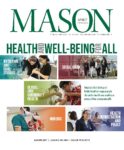During spring 2014, area zoo enthusiasts celebrated the birth of 10 red panda cubs at the Smithsonian Conservation Biology Institute (SCBI) in Front Royal, Va., a partner in George Mason University’s Smithsonian-Mason School of Conservation. For Mason conservation biologist Elizabeth Freeman, PhD Environmental Science and Public Policy ’05, these births meant more than great photos of the fuzzy bundles. For Freeman, the new cubs represent the potential to improve captive breeding programs and species survival around the world.

One of 10 red panda cubs born at the Smithsonian Conservation Biology Institute. Photo courtesy of Smithsonian Conservation Biology Institute
Many may know Freeman for her study of reproductive behavior of elephants in South Africa and her similar study of black rhinos. Her work with red pandas is relatively new. Having spent more than 10 years studying elephants, she expanded her focus to help revitalize the institute’s red panda research program.
“We started with smaller studies of the captive animals at SCBI, then expanded the research to China. We hope to expand to Nepal where we will be looking at wild populations,” says Freeman, who is also an associate professor in New Century College.
One major component of Freeman’s research is hormone monitoring and observation of female red pandas to identify any characteristics that would indicate their pregnancy and the imminence of giving birth. Freeman says, “There is no easy way to confirm pregnancy or when birth will occur. If we knew this, we could make sure management plans are in place to help ensure successful births.” The survival rate for red panda cubs is only about 50 percent.
Freeman secured a New Century College grant to purchase 10 motion-activated video cameras placed within the females’ nesting boxes, which is where they give birth and care for the newborn cubs. She says, “We now can watch inside the nesting box. The months immediately after birth are a critical time to observe how the moms are caring for their cubs.”
Freeman explained this observation could lead to medical intervention, especially if the mother or cub appears to be in distress during labor or following birth. For instance, one cub is being hand-reared by institute staff because its mother has a history of not rearing her cubs successfully.
Freeman makes it a point to share her research opportunities with undergraduate and graduate students alike, including Smithsonian-Mason School of Conservation students. In 2013, New Century College alumna Kendall Bilbrey, BS Integrative Studies ’12, traveled to China to collect data on the red pandas in collaboration with the Chengdu Research Base of Giant Panda Breeding. Freeman notes there are many ways for students to assist with research at the institute through such activities as cleaning animal habitats, monitoring animal behaviors, observing mothers and newborns, and even collecting animal fecal samples, which are tested for the presence of certain hormones.
The species Freeman studies face many threats in the wild. Habitat degradation and loss, poaching, human-animal conflict and many other issues threaten species survival. Freeman maintains a positive outlook about the field of conservation biology, though.
“It’s tough. I get frustrated about how human-focused we are,” she says. “To counter this, I try to focus on the small changes I see happening around the world and here in the classroom. I may not be the next Jane Goodall, but I know I can make an impact by teaching the next generation.”
This spring, Freeman is teaching NCLC 475 Conservation Behavior. This course includes weekly research trips to the Smithsonian’s National Zoo, where Freeman encourages students to appreciate the species within this rich local resource. She says, “There is so much we can learn from the captive population. I enjoy giving the students another view of animals that are right here in our back yard.”
Through all her courses Freeman says, “I hope the students gain an appreciation and understanding for the other species on the planet. We are all part of this global environment, and I hope the students gain a sense of mindfulness and awareness of this interconnectedness.”
—Carrie Drummond



No Comments Yet »
Leave a comment